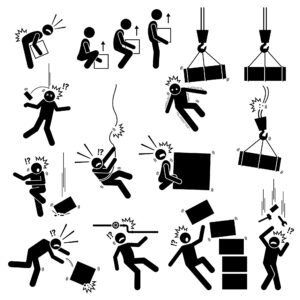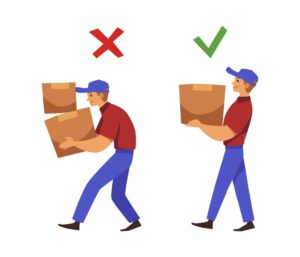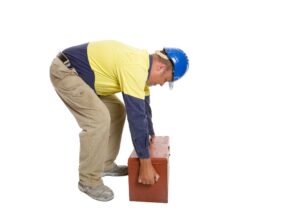Common Jobs And Industries At Risk Of Manual Handling Accidents
Have you been injured in a manual handling accident at work due to negligent actions of your employer? Continue reading this guide if so. We discuss what sectors are more at risk of manual handling accidents, along with industry statistics that show how common manual handling injuries can be.
This guide discusses specific risks of manual handling injuries based on different industries, and what responsibilities employers have to ensure that hazardous manual handling can be avoided.
We also explain, at the end of this guide, the benefits of working with a No Win No Fee specialist personal injury solicitor from our expert panel. You can contact our team today to have a free discussion about your case and your workplace accident claim eligibility. Here are our contact options, all live 24/7:
- Call 020 3870 4868.
- Claim Online by entering your details on this form.
- Send a message in our live chat box.

Jump To A Section
- Sectors At Risk Of Manual Handling Accidents
- The Risk Of Manual Handling Accidents In Transportation And Logistics
- What Is The Risk Of Manual Handling Accidents In Construction?
- Moving And Handling Risks In Health And Social Care
- Manual Handling Risks In Retail And Warehousing
- Speak To Our Team About Claiming For An Injury After A Manual Handling Accident
Sectors At Risk Of Manual Handling Accidents
There are some job roles where you will be exposed to the risks of manual handling accidents more than others. Manual handling is the transportation of a load or item using bodily force. Pushing, carrying, lifting, and lowering can all be done to complete a manual handling task.
The Manual Handling Operations Regulations 1992 requires employers, as is reasonably practicable, to avoid manual handling that creates a risk of an employee being injured. Where hazardous manual handling cannot be avoided, employers must assess and reduce the risk of an employee being injured.
With manual handling, the degree of risk varies based on the nature of the load, how often manual handling activities are carried out, the circumstances of how the manual handling task takes place, and how much the load weighs.
The transportation industry, construction, the health and social care industry, and retail and warehousing are all industries that are at a higher risk of manual handling injuries. We look at each of these sectors.

Manual Handling Injuries Statistics
The Reporting of Injuries, Diseases, and Dangerous Occurrences Regulations 2013 (RIDDOR) states that certain workplace accidents, injuries, and incidents must be reported to the Health and Safety Executive (HSE). The HSE is Great Britain’s workplace safety regulator. They also produce workplace accident statistics based on these recordings. Predominantly, the statistics that you will find in this guide are from the HSE.
According to the HSE, almost 2 million people in Great Britain between 2022/23 suffered from a work-related illness or injury. Of these people, 473,000 suffered a musculoskeletal disorder (MSD). MSDs are injuries to the bones, joints, and muscles, and are common types of injuries to sustain following a manual handling accident.
Furthermore, between 2022/23 in Great Britain, 17% of all workplace non-fatal injuries were caused by handling, carrying or lifting.
Since manual handling injuries can be of a serious nature, it is important to seek help if you have been injured. Contact our team today and they can provide you with guidance on whether you could make a personal injury claim after a manual handling accident at work.
The Risk Of Manual Handling Accidents In Transportation And Logistics
The HSE also publish accident at work statistics from the Labour Force Survey LFS. From the LFS recorded on the HSE website on an annual average, for the last 3 years, per 100,000 workers, there have been 1,860 cases of self-reported non-fatal workplace injuries and 3,430 work-realted illnesses within the transportation and storage industry.
29,000 workers sustained non-fatal injuries at work averaged over the three-year
period 2020/21-2022/23. Of these non-fatal injuries, 21% were due to lifting, carrying, or handling. This makes manual handling the second most common type of accident leading to non-fatal injuries within this industry.
Here are some measures that can be taken to reduce the risks of manual handling accidents within the transportation and logistics industry:
- Identify the tasks that pose the biggest risks using the free HSE Manual Handling Assessment Chart (MAC).
- Consider the use of mechanical aid, such as pallet trucks and scissor lifts, to help with manual handling tasks.
- Consider how a load can be changed so it is easier to carry, such as providing handles or making the packages smaller.
- Make sure that roll cages are loaded sensibly and secured properly in the vehicle and that the access on the delivery end is relatively clear of obstructions or potholes.
What Is The Risk Of Manual Handling Accidents In Construction?
From the Labour Force Survey, the HSE recorded that, on an annual average, for the last 3 years, per 100,000 workers, there have been 2,640 cases of self-reported non-fatal workplace injuries and 3,430 reports of work-related ill health in the construction industry. This makes this industry the second highest for self-reported non-fatal workplace injuries, according to the LFS.
53,000 workers sustained non-fatal injuries at work averaged over the three-year
period 2020/21-2022/23. Of these non-fatal injuries, 17% were due to lifting, carrying, or handling. What’s more, according to the LFS (2020/21 – 2021/23), there were an estimated 69,000 construction workers suffering from work-related ill health, and 54% of these self-reported illnesses in construction were work-related musculoskeletal disorders.
When it comes to hazardous manual handling, employers, where possible, should avoid such tasks. Where hazardous manual handling cannot be avoided, employers should provide mechanical handling aids when possible (for example, grabs when paving).
Where mechanical handling aids are used, they should have maintenance checks regularly to ensure they are in good condition and that they are safe to use. Also, employers need to ensure that employees receive the appropriate manual handling training to know how to use the equipment correctly.
When manual handling is necessary on a construction site, things that can be done to reduce the risk of injury include:
- Setting weight limits and limits on the size of commonly used products.
- Training employees with safe lifting techniques.
- When possible, reduce the height that loads need to be lifted by, and the distance that loads need to be carried by.
- Make sure that ordered bags of materials are a small and easy-to-handle size.

Moving And Handling Risks In Health And Social Care
From the Labour Force Survey, according to the HSE, there were more self-reported illnesses within the human health and social work sector than in any other industry. On average, annually, for the last 3 years, per 100,000 workers, there have been 1,780 cases of self-reported work-related injury and 6,860 work-related illnesses.
To ensure that the risks of manual handling injuries are managed safely, there should be a clear statement of policy implemented, which is supported by the organisation’s arrangements. Key elements of the statement should include recognising the risks and reducing those risks by introducing precautions. Also, arranging for the appropriate manual handling training so that employees can do their job safely.
What employers must do to reduce the risk of injury to employees in care services?
- Avoid, when reasonably possible, manual handling tasks that could cause an injury.
- Assess the risks of manual handling tasks that cannot be avoided.
- As is reasonably possible, putting measures in place to reduce the identified risks.
What employees must do to reduce the risk of injury?
- Use the appropriate equipment provided to follow the health and safety systems of work.
- Inform the employer of any problems or unidentified risks.
- Take care to make sure that their actions are not putting themselves or other employees at risk.
Manual Handling Risks In Retail And Warehousing nn
From the Labour Force Survey, the HSE recorded that on average for the last 3 years, per 100,000 workers, there have been 1,960 cases of self-reported non-fatal workplace injuries every 12 months in the retail trade industry.
Employers in this industry should first conduct a risk assessment for the risk of musculoskeletal injuries. This risk assessment should take into account the individual capacities of each employee and the work environment, as some factors. The assessment should also take into account main risk factors, such as awkward postures and vibrations from any mechanical equipment used to aid in manually handling the loads.
Employers in the retail and warehousing sector, in practice, found that involving employees on the risk assessment and working cohesively to investigate accidents are most successful in reducing the risk of musculoskeletal injuries.

Speak To Our Team About Claiming For An Injury After A Manual Handling Accident
If you have suffered an injury from a manual handling accident, and your employer did not follow manual handling procedures to reduce the risk of you being injured, then you may be able to pursue an accident at work claim. For a chance to start a manual handling claim with us, talk to our team about your circumstances. If your claim is deemed eligible, you will be passed onto our panel of No Win No Fee solicitors. They specifically offer their claimants Conditional Fee Agreements (CFAs).
If your personal injury claim is represented under a CFA, you will not be asked to pay any fees for your solicitor’s services before or during the claims procedure. This also applies if your claim is considered unsuccessful.
Alternatively, if your claim is successful, a small percentage will be taken from your compensation, called the success fee. There is a legal cap on what can be taken as the success fee to ensure that you get most of your award.
Contact Us
Speak to our team today about the risk of manual handling accidents and to see whether you can sue your employer for any injuries you have sustained. Our panel of solicitors have represented many manual handling claims in the past and can use their expertise to help you as much as they can.
- Call 020 3870 4868.
- Claim Online by entering your details on this form.
- Send a message in our live chat box.
Extra Resources
If you have found this guide useful, you might want to browse these extra materials.
Our similar guides:
- Information on making a personal injury claim for back pain.
- Learn how you can prove employer liability for your manual handling accident at work.
- Find out when it could be possible to return to work after an injury if you have needed time off work following your manual handling accident.
- What evidence is needed for foot injuries at work – find out with this guide
Extra related resources from other websites:
- HSE – a published brief guide on manual handling at work, going into detail about risk assessments.
- NHS – if you have an injury or illness, look at what NHS services are near you.
- More from the Health and Safety Executive HSE on regulations regarding the process of manual handling operation.
Thank you for reading this guide talking about the risk of manual handling accidents and how your employer could cause you to suffer a workplace injury by not following health and safety procedures. Speak with our team to confirm who is liable for your injuries and to possibly pursue the process of claiming compensation.





